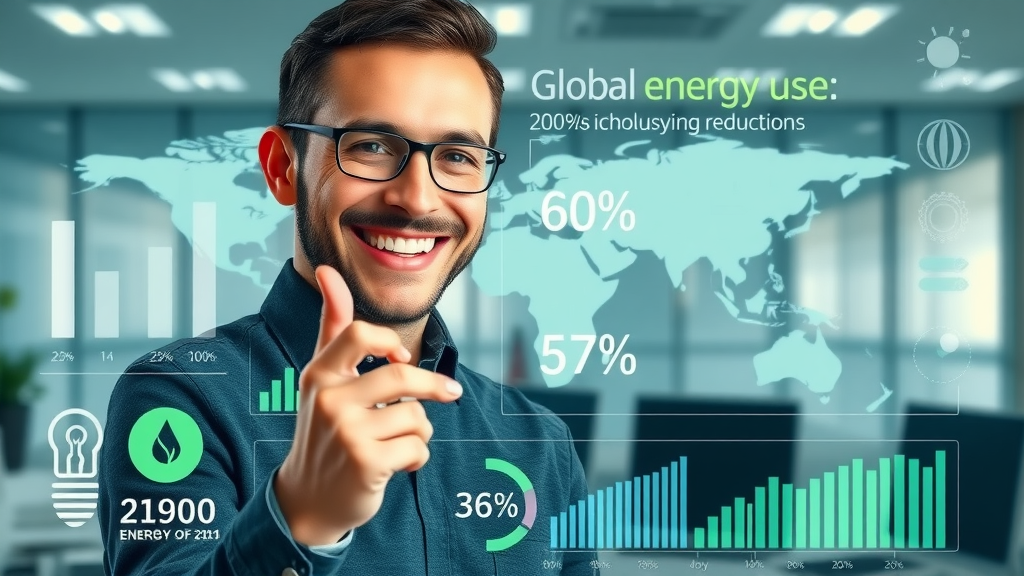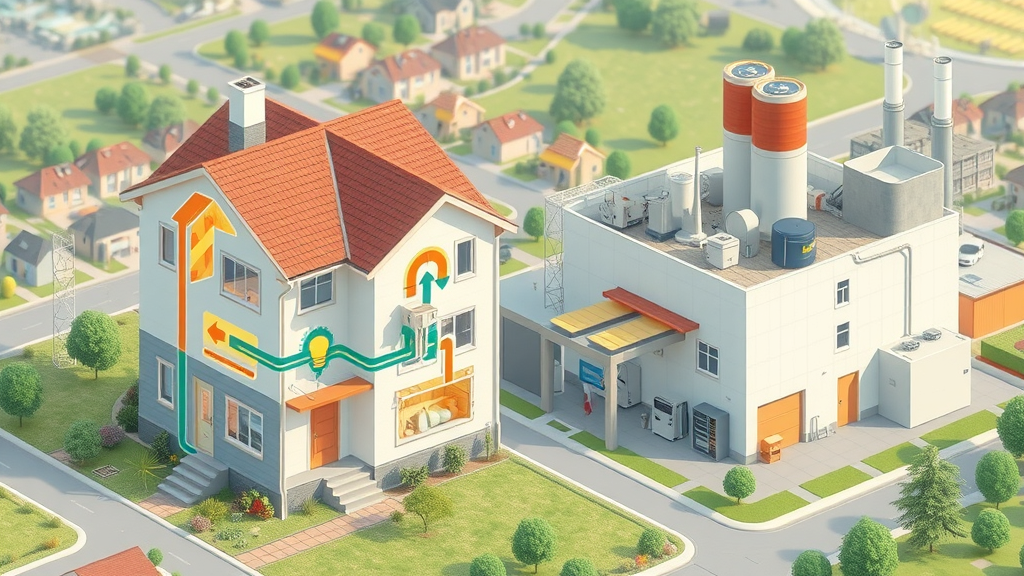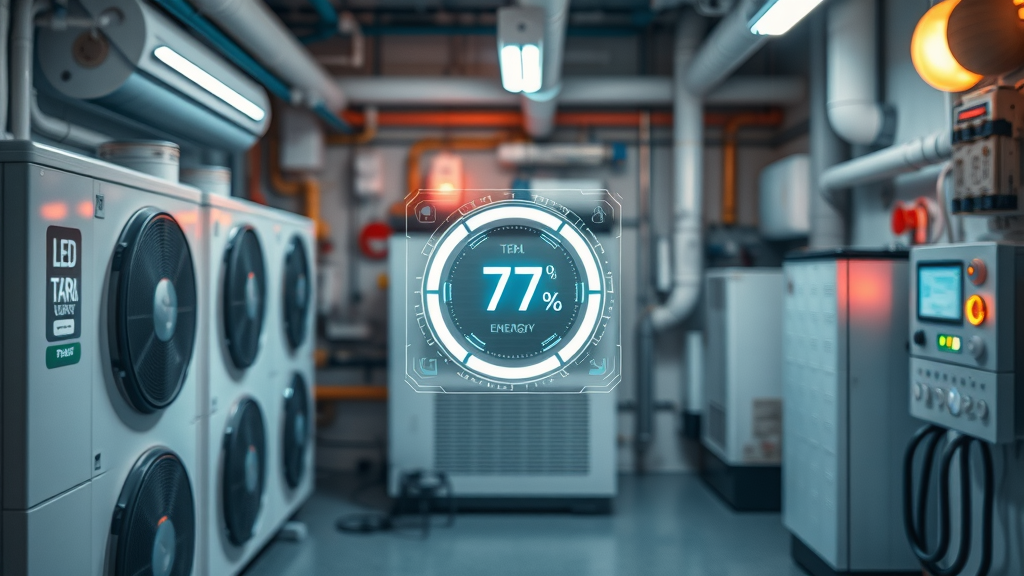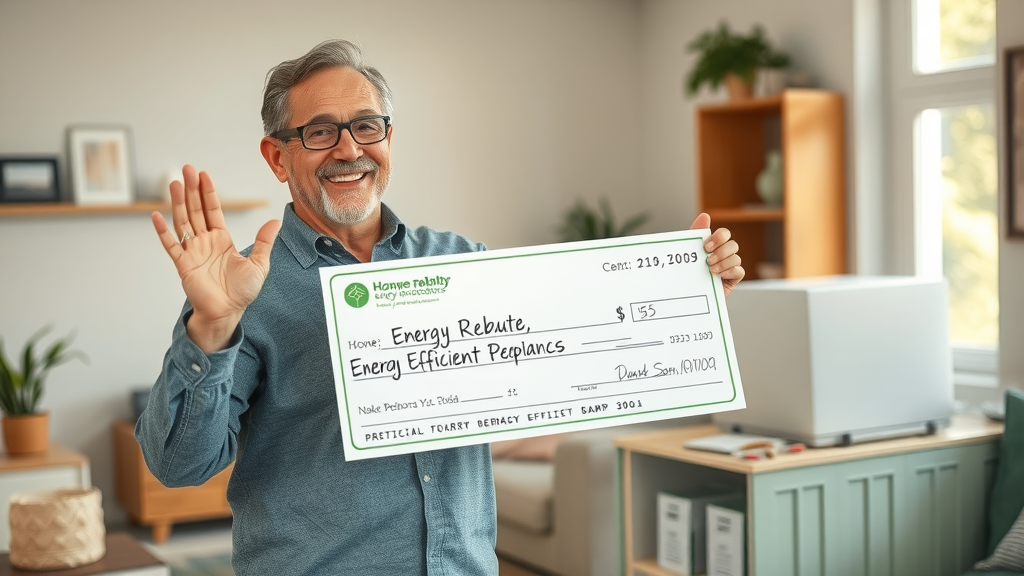Did you know that by 2050, boosting energy efficiency could eliminate nearly half of the greenhouse gas emissions needed to achieve global climate targets? The numbers are not just impressive—they’re revolutionary. Energy efficiency is quickly becoming a top priority for homes, businesses, and industries worldwide, slashing costs, reducing environmental impact, and shaping a more sustainable future. But what exactly does energy efficiency mean for you in 2024, and how can you start unlocking these benefits? Let’s dive into the facts, strategies, and secrets behind this game-changing approach to energy savings!
Startling Facts: Why Energy Efficiency Matters in 2025
In 2025, energy efficiency stands at the forefront of global economic and environmental agendas. With rising energy bills, volatile natural gas prices, and the imperative to reduce emissions, businesses and households are under growing pressure to make smarter energy choices. According to the International Energy Agency, if we all adopted modern energy efficiency technologies and practices, we could avoid almost half the greenhouse gas emissions needed to address climate change—a target deemed essential by experts around the world. This is not just about doing good for the planet; it’s about substantial cost savings for your wallet and long-term energy security for your family and business.
The impact is evident across every sector of the economy, from the growing popularity of efficient heat pumps in homes to advanced automation in manufacturing. In the United States, updated energy efficiency standards are reshaping how industries operate, with a marked focus on energy conservation, smarter technology, and stricter regulations. Whether you lead a manufacturing facility or are seeking ways to cut your home’s utility bill, understanding and leveraging these advancements can make a measurable difference in both your expenses and your carbon footprint.

"According to the International Energy Agency, improving energy efficiency could help the world avoid nearly half of the greenhouse gas emissions needed to meet global climate goals by 2050."
What You'll Learn About Energy Efficiency
Understand the fundamentals of energy efficiency and how it impacts your business and daily life
Explore top energy efficiency measures and technologies
Compare energy efficiency standards like ENERGY STAR and A to G rating systems
Identify actionable steps to increase energy savings in the home and industrial sectors
Learn how companies are adapting to global trade shifts and energy demands
For those looking to maximize their savings, it's worth noting that energy efficiency upgrades can also open the door to valuable tax incentives. If you're interested in how these improvements can directly impact your bottom line, explore the details of the Energy Efficient Home Improvement Tax Credit and discover how strategic upgrades can lead to both immediate and long-term financial benefits.
Defining Energy Efficiency: Concepts and Core Principles
The concept of energy efficiency might sound technical, but at its core, it’s surprisingly simple. Energy efficiency means using less energy to perform the same task, deliver the same service, or achieve the same outcome. Think of it as squeezing more value out of every unit of energy consumed—whether you’re lighting your home, powering your business, or heating your water. As technologies improve and awareness grows, the possibilities for enhanced energy savings are expanding dramatically, offering real financial and environmental returns.
The principles of energy efficiency operate on all scales. In a typical building, for example, swapping out standing air conditioners for modern heat pumps or using LED lighting instead of incandescent bulbs yields immediate reductions in energy consumption. For industrial manufacturers, deploying next-generation sensors or automating production lines not only cuts energy waste but also boosts competitiveness in volatile energy markets. The bottom line: energy efficiency is about doing more with less—and realizing the benefits through lower bills, reduced emissions, and greater comfort.
What is Meant by Energy Efficiency?
Energy efficiency refers to maximizing the output you get for every unit of energy consumed. If you’ve ever replaced a traditional water heater or an old air conditioner with an ENERGY STAR model, you’ve already embraced energy efficiency. In today’s landscape, this concept extends far beyond appliances—it includes building insulation, smart thermostats, automated manufacturing, and more. Efficient systems have lower energy waste and provide the same or better results with fewer greenhouse gas emissions, helping to tackle climate change and enhance energy security worldwide.
For both homeowners and businesses, embracing the latest efficiency measures means slashing utility bills, boosting property value, and strengthening the overall energy resilience of their operations. By taking consistent, well-planned steps, you can multiply energy savings and significantly lower your carbon footprint—without sacrificing comfort, productivity, or style.

Energy Efficiency and Energy Consumption: Key Differences
While energy consumption refers to the total amount of energy used by an individual, household, or business, energy efficiency measures seek to reduce the demand for energy without sacrificing performance. It’s important to understand that adopting efficiency does not always equate to using less energy outright—rather, it’s about getting the maximum benefit from each kilowatt-hour. For instance, a home equipped with a modern heat pump for heating and cooling may consume less natural gas and electricity than one using outdated systems, leading to substantial cost and emission reductions over time.
The key takeaway is that energy efficiency is a tool for managing energy consumption smartly. By focusing on technologies and practices that reduce energy waste and improve system performance, homeowners and enterprises alike can proactively manage costs, comply with environmental regulations, and future-proof against rising utility rates and environmental constraints.
Benefits of Energy Efficiency Initiatives for Consumers and Manufacturers
The advantages of advancing energy efficiency stretch far beyond mere energy savings. For consumers, the most visible impact is often the drop in monthly utility bills, thanks to cost-effective upgrades like LED lighting, enhanced insulation, and programmable thermostats. But the benefits extend to increased comfort, better indoor air quality, and greater reliability during power disruptions—especially as climate extremes put additional strain on the grid.
For manufacturers and large businesses, efficiency leads to reduced overhead, a stronger market position, and improved compliance with current and future energy regulations. Implementing state-of-the-art automation, upgrading to high-performance heat pumps, and optimizing natural gas usage can all contribute to significant financial savings while demonstrating corporate responsibility. Across sectors, the push for energy efficiency also aligns with efforts to reduce emissions and promote a sustainable, low-carbon economy.
What Are the Benefits of Energy Efficiency?
Energy efficiency brings a host of valuable benefits for both individual consumers and organizations. First, it translates into concrete cost savings by lowering energy bills and reducing the frequency of expensive upgrades or repairs. Efficient buildings stay comfortable year-round, with less reliance on natural gas or electricity for heating, cooling, and lighting—cutting financial risk amid rising energy prices. Secondly, it directly supports efforts to reduce greenhouse gas emissions, playing a crucial role in combating climate change and advancing public health. Third, robust energy efficiency initiatives boost energy security by lessening dependence on external energy supplies and volatile fuel markets.
Finally, energy efficiency often leads to improved property value, longer-lasting systems, and more resilient infrastructure. The investment pays off both in the short term—through lower daily energy consumption—and in the long haul—by fostering cleaner, more sustainable communities.

Real-Life Examples and Measures: Energy Efficiency in Action
From the home to the factory floor, practical steps to optimize energy efficiency are transforming the way we live and work. Picture a kitchen where every major appliance is ENERGY STAR certified, LED bulbs brighten up the space, and a programmable thermostat keeps heating and cooling perfectly tuned—all for a fraction of yesterday’s energy cost. In industrial settings, intelligent automation and high-efficiency motors seamlessly manage production lines, reducing energy waste and maximizing productivity.
Simple upgrades such as improving insulation, sealing windows, and regularly maintaining heating and cooling equipment can yield double-digit percentage reductions in energy consumption. Even small behavior changes, like unplugging idle devices or setting your water heater to an optimal temperature, can add up to surprising energy savings year over year. Industrial sectors are also realizing major gains by investing in efficiency audits, process optimization, and electrification strategies that reduce reliance on fossil fuels.
What is an Example of Energy Efficiency?
Installing an ENERGY STAR refrigerator that uses far less electricity than a non-certified model is an ideal example of energy efficiency in action. Other strong examples include replacing incandescent bulbs with LED lighting, upgrading to high-efficiency heat pumps for both air and water heating, and installing a smart thermostat that automates heating and cooling based on your schedule and preferences. In industry, swapping out outdated motors for ultra-efficient models or using advanced analytics to optimize production are also excellent illustrations of modern efficiency measures.
No matter the application, the underlying principle is the same: energy efficient technologies do more, waste less, and provide measurable financial and environmental returns over time.

Comparing Energy Efficiency Ratings: ENERGY STAR, A to G, and More
Before making any major purchase—be it an air conditioner, water heater, or household appliance—consumers should understand and compare popular energy efficiency rating systems. In the United States, the ENERGY STAR program is the gold standard, signaling products that are independently certified to save energy without compromising performance. Across Europe and other global markets, the A to G energy rating system provides a similar function, grading products from most (A) to least (G) efficient based on strict benchmarks.
Reading and comparing ratings not only helps you select the best efficiency option but also yields big cost savings and helps you comply with evolving regional energy policies. These ratings encourage manufacturers to compete on energy performance, driving up quality and driving down emissions across the board.
What is the A to G Energy Rating?
The A to G energy rating system provides a simple, easy-to-follow scale for assessing the efficiency of products such as air conditioners, water heaters, and household appliances. "A" represents the highest level of energy efficiency, while "G" indicates the lowest. This system, widely used in Europe, enables consumers to quickly identify which products offer superior energy savings and will ultimately cost less to operate. Combined with programs like ENERGY STAR in the United States, these labels drive broader market adoption of efficient solutions—lowering household and business utility bills and making a tangible impact on greenhouse gas emissions worldwide.
Comparison of Leading Energy Efficiency Rating Systems (ENERGY STAR vs. A to G) |
||
Criteria |
ENERGY STAR |
A to G (EU Label) |
|---|---|---|
Coverage |
Appliances, Lighting, HVAC, Buildings |
Appliances, Lighting, Electronics |
Scoring/Grades |
Certified Pass/Fail (Qualified Products) |
Graded A (most efficient) to G (least efficient) |
Recognition |
Widely used in United States and internationally |
Standard across European Union and select global markets |
Key Technologies Driving Energy Efficiency Improvements
Heat pumps: Upgrading traditional air conditioners and water heaters
Smart thermostats and controls
LED lighting and efficient fixtures
Insulation and building envelope improvements
Natural gas alternatives and electrification
Industrial efficiency measures and automation
The drive for energy efficiency is powered by continuous innovation. Heat pumps now outperform conventional air conditioners and water heaters, slashing both costs and energy consumption. Smart thermostats allow for precise, automated control of indoor temperatures—adapting to your routine and maximizing comfort without wasting energy. Meanwhile, advances in LED lighting and enhanced insulation reduce heat loss or gain in buildings, creating more resilient and cost-effective structures.

On the industrial side, investments in process automation, advanced metering, and electrification are transforming heavy energy users into lean, efficient powerhouses. These upgrades don’t just lower operational costs—they also pave the way for a low-carbon, competitive future.
Energy Efficiency in Buildings: Best Practices and Upgrades
Modern buildings—residential, commercial, or industrial—are on the frontline of the energy efficiency revolution. Best practices begin with a comprehensive energy audit to identify leaks, inefficiencies, and opportunities for major savings. Top upgrades include sealing windows and doors, adding high-grade insulation, retrofitting with LED lighting, and installing programmable thermostats for year-round savings. Smart building systems now allow property managers and homeowners to monitor and adjust energy consumption in real-time, ensuring that every dollar spent translates into tangible performance and comfort gains.
The biggest savings often come from systems that address both envelope and operational losses—such as advanced controls for heating and cooling, mechanical ventilation with heat recovery, and high-efficiency hot water systems. Combining these improvements creates synergistic energy savings, slashes utility bills, and boosts property market value.
Top Efficiency Measures for Residential and Commercial Spaces
For residential spaces, start with the basics: swap out old bulbs for LED lighting, upgrade insulation, switch to high-efficiency heat pumps, and install a smart thermostat. Commercial operations should prioritize advanced building management systems, implement energy usage analytics, upgrade HVAC and water heating equipment, and encourage staff to follow energy conservation habits. Both sectors benefit from regular maintenance of heating and cooling systems, prompt repair of leaks, and professional audits to guide ongoing upgrades.

While some upgrades, like window replacement or full-system renovations, require significant investment, the payback in savings, comfort, and reliability is well worth it. With government incentives and utility company rebates, these efficiency projects are more accessible than ever before.
Industrial Energy Efficiency: A Manufacturer's Guide in 2024
Industrial operations are among the largest energy consumers worldwide, making them critical to the energy efficiency conversation. Progressive manufacturers are embracing process automation, real-time energy monitoring, and ©lean manufacturing methodologies to not only cut costs, but also comply with evolving climate change and trade policies. In a global context, companies that adopt aggressive efficiency measures can maintain a competitive edge, meet ESG (Environmental, Social, Governance) standards, and avoid exposure to carbon tariffs or trade disruptions.
How to Embrace Energy Efficiency Amid Global Trade Shifts
By deploying state-of-the-art automation, real-time analytics, and targeted process upgrades, manufacturers can drive energy efficiency even as global trade conditions shift. Their use of advanced digital dashboards provides detailed insights into energy consumption, allowing continuous optimization of critical manufacturing lines. These improvements reduce dependency on volatile natural gas supplies and help buffer against international supply chain disruptions—while supporting ambitious climate and energy policy goals.

Successful adaptation highlights a blueprint any forward-thinking manufacturer can follow: invest in energy-efficient equipment, monitor usage closely, and foster a culture of continuous efficiency improvements to navigate today’s trade and sustainability challenges.
Financial Incentives and Policy Support for Energy Efficiency
Government bodies and utilities in the United States and abroad recognize the importance of scaling up energy efficiency initiatives. As a result, a growing number of financial incentives, tax credits, and rebates are now available for both residential and commercial efficiency improvements. From federal ENERGY STAR rebates to state-level incentive programs, these financial tools help defray upfront investment costs, accelerate payback timelines, and make adoption more attractive to businesses and homeowners alike.
Popular rebates and incentives can target new appliance purchases, insulation upgrades, HVAC replacements, and even whole-building retrofits. It’s important to research official government websites and consult with licensed contractors to identify the best opportunities and ensure compliance with program requirements.
Government Incentives and ENERGY STAR Rebates
Federal and state agencies, in collaboration with utility companies, offer robust support for energy efficiency upgrades—commonly providing rebates for purchasing ENERGY STAR appliances, installing advanced HVAC systems, or increasing home insulation. These programs are accessible through most gov websites and can substantially reduce the overall investment required for efficiency improvements. Businesses pursuing commercial projects often enjoy additional tax incentives by following official guidelines and demonstrating substantial long-term energy savings.

If you’re considering a major upgrade to your home or business, make sure to check for available rebates and incentives to maximize your return on investment while supporting the transition to a sustainable energy future.
Step-by-Step: How to Achieve Maximum Energy Savings
Audit your current energy consumption profile
Identify priority upgrades (heat pumps, air conditioners, insulation)
Purchase ENERGY STAR or A-rated equipment
Implement energy conservation behaviors
Monitor performance, adapt, and scale efficiency measures
Getting started with energy efficiency doesn’t require expert knowledge or huge capital. Begin by analyzing how much energy your facility or household currently uses—looking for usage patterns, old appliances, and obvious waste. Next, target the most impactful upgrades, which often include swapping out water heaters and air conditioners for higher-efficiency models and tightening up insulation. Always look for verified ENERGY STAR or top-scoring A to G products for guaranteed performance. Pair these investments with everyday energy conservation habits, such as turning off unnecessary lights and fine-tuning system settings. Lastly, review your utility bill and system dashboards consistently to ensure your energy saving strategies are paying off and refine your approach as technology evolves.
Common Myths and Misconceptions on Energy Efficiency
Energy efficiency is too expensive upfront
Only new buildings benefit from efficiency measures
Energy efficient appliances do not make a difference
Natural gas can’t be optimized for efficiency
Despite overwhelming evidence, several outdated myths still prevent many from embracing energy efficiency. Many believe that upgrading costs too much or only yields small savings—but with government incentives and falling prices for efficient products, payback is faster than ever before. Others mistakenly think improvements only work for newly built homes or businesses. In fact, existing structures often stand to benefit most from targeted upgrades. Some say that one efficient appliance won’t move the needle, but even small changes accumulate massive energy savings over the years—while the myth that natural gas can’t be used efficiently is disproven by recent advances in high-efficiency gas heating and hybrid systems.
"Investing in energy efficiency pays for itself while improving comfort and resilience across sectors."
Key Takeaways: Energy Efficiency for a Smart, Sustainable Future
Energy efficiency reduces costs, emissions, and dependence on volatile energy supply.
Smart upgrades make a measurable difference at all scales.
Incentives support a faster return on investment.
Adaptation to global trade policy changes can give manufacturers a critical edge.
People Also Ask About Energy Efficiency
What is meant by energy efficiency?
Energy efficiency means getting the same level of service or output while using less energy. For example, an energy efficient heat pump heats your home with less electricity than an older system. The goal is to reduce waste, save money, and lower harmful greenhouse gas emissions—all while making daily life more comfortable and secure.
What is an example of energy efficiency?
Examples include upgrading to an ENERGY STAR refrigerator, installing LED lighting, or using a programmable thermostat to optimize heating and cooling. In industry, adopting automation technologies and smarter controls can cut energy waste while boosting production, resulting in lower energy bills and a reduced carbon footprint.
What is the A to G energy rating?
The A to G energy rating is a European classification that ranks appliances and equipment from A (most energy efficient) to G (least efficient). Products with higher ratings require less energy to operate, leading to long-term savings and less environmental impact. This system guides consumers and businesses toward smarter purchases.
What are the benefits of energy efficiency?
Benefits include lower utility bills, improved comfort, reduced dependence on volatile energy markets, decreased greenhouse gas emissions, and increased property value. It also supports overall energy security and strengthens resilience to climate and supply chain disruptions.
Frequently Asked Questions About Energy Efficiency
How can I calculate my energy savings from efficiency upgrades?
What tax incentives are available for commercial efficiency projects?
Does switching to heat pumps always save energy?
How do I get an ENERGY STAR rating for my business?
Conclusion: Take Charge—Start Your Journey to Energy Efficiency Today
Embracing energy efficiency delivers ongoing financial and environmental rewards—don’t wait to start making changes that pay off for you, your business, and the planet!
As you continue your journey toward smarter energy use, remember that energy efficiency is just one piece of the puzzle in building a resilient and future-ready business. For a broader perspective on how global economic trends and trade developments can influence your strategy, explore our in-depth analysis on economic growth insights for importers and exporters in 2025. By staying informed about both energy and market dynamics, you’ll be better equipped to make decisions that drive sustainable growth and long-term success.
Subscribe to Global Trade News for the latest updates. Call 203-271-7991 today.
To deepen your understanding of energy efficiency and its practical applications, consider exploring the following resources:
“Energy Efficiency | ENERGY STAR”: This resource provides comprehensive information on energy efficiency, including examples, benefits, and guidance on selecting energy-efficient products and homes. (energystar.gov)
“Federal Tax Credits for Energy Efficiency | ENERGY STAR”: This page details federal tax credits available through the end of 2025, offering homeowners up to $3,200 to offset the cost of energy-efficient home upgrades by up to 30%. (energystar.gov)
These resources offer valuable insights and practical steps to enhance energy efficiency in your home or business, leading to cost savings and environmental benefits.
 Add Row
Add Row  Add
Add 




Write A Comment